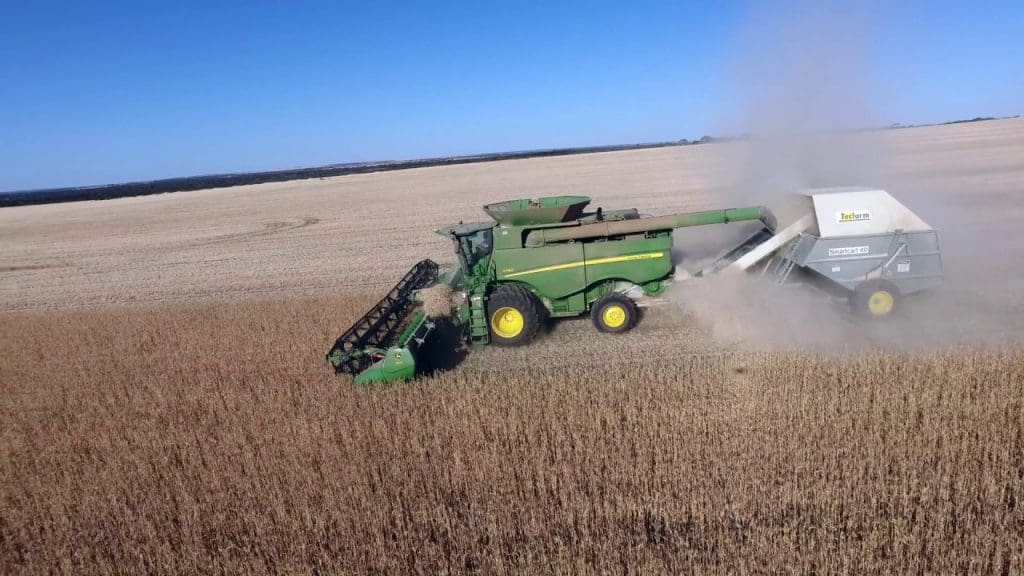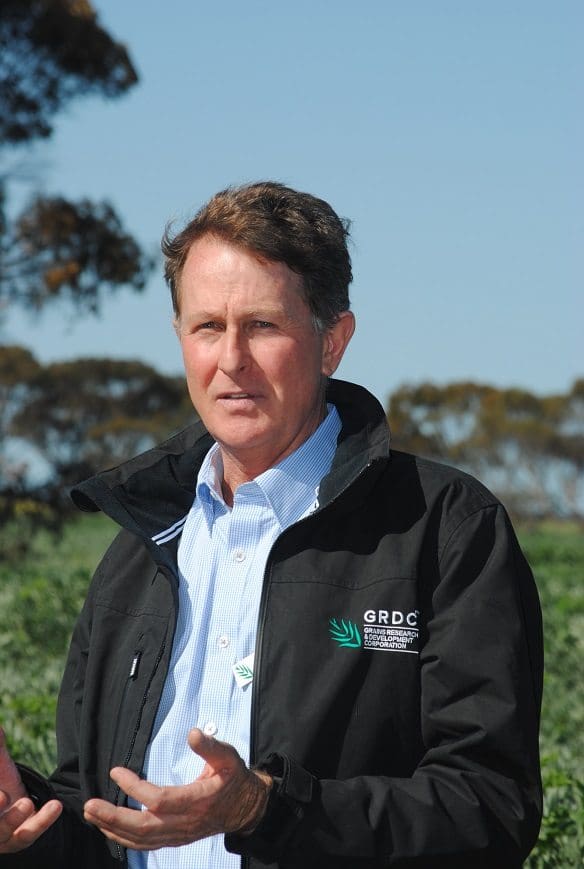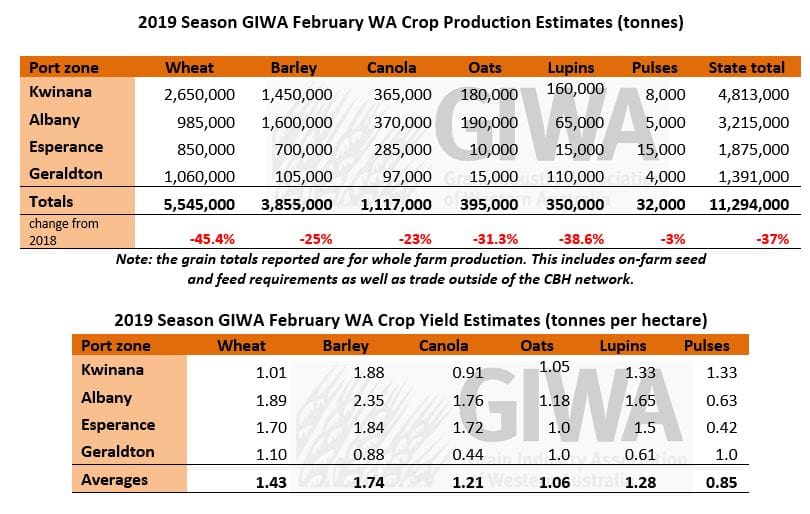
THE 2019 Western Australian grain season was a story of extremes with some areas doing well and others having a season they’d rather forget, according to a review of the past winter cropping year by the Grain Industry Association of WA (GIWA).
GIWA Oilseeds Council chair and crop review author, Michael Lamond, said in the north of the state grain yields were more than 50 per cent below 2018 – and in some cases up to 75pc below 2018 – for all crops, except oats.
“The northern areas had a low production year with no subsoil moisture, a late break and a short growing season. In the old days you wouldn’t have got a crop at all,” he said.
Moving south, Mr Lamond said the combination of severe frost followed by very hot windy conditions resulted in unprecedented loss of production for some growers in.

Michael Lamond
“This was most evident in the south coast where some growers had their “best ever” result due to the lack of waterlogging, others had their “worst ever result” due to the lack of rain and frost,” he said.
“In traditionally higher rainfall regions of the south west, grain yields were spectacular and grain quality excellent, with some regions returning the highest whole paddocks grain yields ever.”
Mr Lamond said during the 2019 harvest, grain quality was “all over the place”, with some growers delivering into more segregations than ever before due to the range in protein and screenings.
“Having the ability to deliver into the number of segregations required (due to the wide range in grain quality) was a credit to the grain handling system in the State. Reflecting market signals, the lack of price spread for protein reinforced the message to mostly “grow for yield”,” he said.
On the upside, Mr Lamond said a standout from last year was the very good weed control achieved by growers loading up with pre-emergent herbicides when faced with the second year in a row without a knockdown.
“Weed control was helped by the season in 2019, although strategies to keep herbicide rates up, use diverse modes of action, and be spot on with post-emergent application timings have also contributed to low weed loads for the impending 2020 season,” he said.
He said another positive was that climate prediction models were becoming more sophisticated each year.
“Predictions in early 2019 were that it was going to be a low decile year and warmer than normal in the spring, which turned out to be correct. Growers are taking more consideration of climate models and whilst many may not have necessarily changed plans based on early seasonal predictions, it certainly was in the reckoning, particularly as the season break became later,” he said.
Looking forward to the 2020 season, Mr Lamond said the main shift in grower’s cropping plans for all areas except the western and south western regions was one of returning to conservative programs and making risk averse decisions around spending and crop type mix.
He predicted there would be more wheat sown in the north and more barley in the south.
“In the north, there is not a lot of barley grown but it was getting back into that area. But with the late start and hot spring last year, barley just didn’t make it,” he said.
“Now with the introduction of Chief wheat which is an Imi-tolerant wheat, growers can get the same benefits from weed control with wheat as they can from barley, particularly with brome grass and barley grass control. We will see barley being substituted with the Imi wheat variety Chief.
“The other thing is that with the very dry year there is probably going to be Imi carryover, so it will be a bit safer to follow barley with an Imi wheat.”
Mr Lamond said the canola area in WA was definitely going to decline.
“Most growers have been backing off canola for the last couple of years. If they get summer rain and an early break they will be back into it in a big way, but without that they will dump it. You can’t find a paddock that is definitely going to go to canola east of the Meckering line. It is only the western areas that have definitely got canola paddocks,” he said.
Likewise, he anticipates the lupin area will also drop back.
“Because lupins are so widely grown now, that could swing a little as well. But most growers have indicated they are not going to sow those break crops dry like they have in the past. They will probably just start with wheat,” he said.
“They need to sow some dry because the programs are so huge nowadays, but they will hold off and not commit until they have to.”
Geraldton Zone
The 2019 growing season for the zone was well below average and in a lot of cases growers lost half of the gains made during the very good 2018 growing season. This will put pressure on farm finances.
Many growers completed their 2020 cropping plans before Christmas. Even though the ameliorated country outperformed the non-ameliorated soils, there will be a reduction in spend on mechanically modified country and the amount of lime going out will be less than in previous years.
The Geraldton Zone wheat area will almost certainly increase at the expense of canola and barley. Most of the lupins and canola will be planted in the safe rainfall zones closer to the coast with an increase in fallow in the eastern areas. Up to half of the total lupin and canola crop area from 2019 could go to fallow rather than be sown to a break crop. Less crop is projected to go in dry to give more flexibility with programs depending on the timing of the break to the season. Weed control was generally very good in 2019 and the cleanest paddocks will be targeted first for dry sowing.
Kwinana Zone
Kwinana North Midlands
Growers in the region were well down on 2018 tonnages with low rainfall and more frost damage than expected showing up at harvest. Wheat generally performed well with barley disappointing and very little making malt grades. The hay crops performed well, propped up by strong prices and there is likely to be a slight shift to more area of hay in 2020 for those growers in the export fodder game. Planned barley area will decrease, and wheat area is likely to go up in the region as forward pricing is strong.
There is strong demand for Chief wheat seed and it is likely there will be a substitution of Imi wheat for Imi barley in 2020. This will be used as both a follow crop where Imi residues may impact on the establishment of sensitive crops in 2020 from the very dry 2019 and for Brome grass control.
The lack of supply of some of the hybrid canola varieties this year (and to some extent the tight cash situation) will see the area of Open Pollinated Triazine Tolerant canola maintain a similar percentage of the are in the north of the state, rather than continue to decrease as it has in recent years.
Water supply is an issue away from the coast where there is no underground supply from the lack of surface run-off in recent years. Continuous cropping of paddocks has reduced the amount of rain run-off and the dry years have exacerbated the problem.
Kwinana South
Grain yields in the western areas of the region were well down on 2018 although most returned just under longer-term averages. Yields dropped off in the east as expected. Due to lack of rain grain quality was very mixed across different soil types and rotations. Grain quality was extremely variable with in some cases the full range of high screenings and low protein, high screenings and high protein, low screenings, and both low and high protein on the one property. There was very little malt barley or quality noodle wheat produced in the region.
Cropping plans will be more risk adverse this year dictated by the timing of the break to the season. It is likely canola in the east will be substituted with fallow unless there is decent summer rain and an early break to the season. Most growers will probably back off on dry-sowing although there is a limit to how much this is an option due to the size of most seeding programs these days.
If there is a late break there will be more pasture for those that have livestock, and there will be more oats as a break crop rather than canola or lupins.
Kwinana North East
There was simply not enough rain in the Kwinana North East region for growers to return anywhere near long-term averages in grain yield. Starting with no subsoil moisture and a late break to the season in 2019, it was always going to be tough. The season in the spring went against growers with the rain cutting out in August and very hot conditions during grain fill.
There was a lot of crown rot in the red country that has been in continuous wheat north of the Great Eastern Highway. Judging by the white heads showing up in the lead up to harvest, the disease certainly had more of an impact on grain yields in 2019 than it may have had in recent years.
Most growers have assessed their fallow country as potentially not having the advantage over cropped paddocks in 2019 due to the lack of crop growth from the dry year.
Most lupins and canola returned very low grain yields and most growers will be planning for fewer break crops this year, sticking with wheat and to a lesser extent barley.
Albany Zone
Albany West
The West Albany region had a very good year and probably the best year ever for cropping in the high rainfall regions west of the Albany Highway, especially for the earlier sown paddocks. Barley was a real standout, consistently 1-1.5t/ha up on long term averages. Some canola yields were nearly unbelievable and highlight what the region can produce if waterlogging is reduced. Wheat grown on pasture was very good, although still behind the top barley yields. The area of wheat overall will continue to be replaced by barley and the area of oats for hay may increase slightly. The reduction in canola area in 2019 will mean there will be less clean country to go into crop in 2020 and this could hold up early planting.
Lupin yields were fantastic with some paddocks going 3t/ha which is unheard of in the south of the state. As a result of this, there will be more lupin planted in 2020 in the region to assist in getting wheat yields up, and for weed control purposes. The continued profitability of sheep will see the pasture area edge up slightly in 2020 as well. The few faba bean paddocks went well again and the area is likely to continue to creep up.
Dams are drying out from the lack of runoff and hot days, and whilst not desperate yet, the situation will become so if there is not some substantial run-off in the next few months.
Albany South
The southern Albany region really was “one extreme to the other” as some growers had their best year ever close to the coast where they escaped the frost, whilst others further east had their worst year ever. Grain yields decreased as you moved east in the zone from the lack of rainfall and frost, with those sowing early getting roasted by the frost followed by the hot conditions which didn’t allow any recovery in crops as is normally the case in the region. A lot of canola returned 200 to 300kgs with the majority being baled. A lot of wheat did not get baled; it probably should have as there was more frost than was thought at the time.
The water deficient areas are working their way west with livestock being turned off and those retained on farm needing to have water trucked in. Water for the cropping programs this year is also a concern for those areas that have not received decent run-off for two years.
Changes to cropping programs in 2020 will see a slight increase in lupins for sheep feed at the expense of canola, and a certain decrease in canola replaced with barley in the eastern regions unless there is some subsoil moisture and an early break.
Whilst snails in grain samples were not as much of a problem as they have been previously, due to the last two dry summers and an increase in windrow burning, they are now present over a very wide area of the region.
Albany East (Lakes Region)
Most crops in the region yielded slightly less than was expected in the lead up to harvest, with wheat returning closer to 1.4t/ha than 1.5 to 1.6t/ha, barley 1.7t/ha and canola 0.6t/ha. Grain quality was very mixed as it was across the state.
In 2019, a small difference of even 10mm in rainfall had a large difference in grain yield for growers, indicating that total rainfall was right on the edge of what was needed by crops to perform to their potential. For most “just one more rain” would have made a huge difference in total grain production.
Most growers will be backing off on their lupin and canola area in 2020, with wheat being substituted by barley and to a lesser extent, oats.
Weed control was good in 2019 considering it was the second year in a row without a knockdown. The mild, wet start to the season resulted in plenty of weeds germinating, although it also meant that weed control was very good.
Esperance Zone
There was a wide variation of grain yields across the zone with very low yields in the north from lack of rain and frost, to very good along the coast due to the lack of waterlogging. The western areas came in better than expected considering the very low rainfall and frost.
Looking ahead to the 2020 growing season, there will be a general tightening of spending for growers in the central and eastern areas of the zone not seen for some time. The western areas have had a run of poor rainfall over the years and are looking forward to a change in rainfall patterns to be able to get programs back on track. The lack of surface water for stock is now desperate with dams mostly completely dry. Growers are having to cart water in most of the western areas and many are concerned about the ability to access enough water for winter cropping programs if there is not substantial runoff in the next few months.
Adjustment in 2020 programs by growers away from the coast will include less expenditure on lime, gypsum and general improvements. Crop rotations will be based more around cereals this year with more barley on barley, and more wheat on wheat, than normal due to disease loading on stubbles being low from the drier than normal 2019 growing season and recent relatively good weed control.
Season Outlook, February 2020
The WA Department of Primary Industries and Regional Development’s Ian Foster said summer rain so far had been well below average over most of the cropping area.
This most likely comes from the Indian Ocean Dipole (IOD) event of 2019. The end of the IOD has allowed a reset in tropical rainfall over northern Australia but this has yet to have much effect further south.
Seasonal rainfall outlooks from the Bureau of Meteorology and other models have mostly neutral rainfall probabilities for southern WA for February to March. This may not bring much rain for traditionally dry areas but is more significant for the northern wet season.
As indicated in the Bureau of Meteorology summary below, rainfall will be influenced more by local and/or short-term weather events (such as a tropical cyclone) rather than large scale phenomena in the Indian and Pacific Oceans.
Bureau of Meteorology seasonal outlook summary
- The likelihood of a wetter or drier than average February to April is roughly equal for much of Australia.
- Both daytime and overnight temperatures for February to April are likely to be above average across almost all of Australia.
- With major climate drivers neutral, local or short-term climate drivers, such as sea surface temperatures around Australia, and active or break periods of the monsoon, are likely to have a greater influence on Australian rainfall and temperature patterns.
Grain Central: Get our free daily cropping news straight to your inbox – Click here


HAVE YOUR SAY